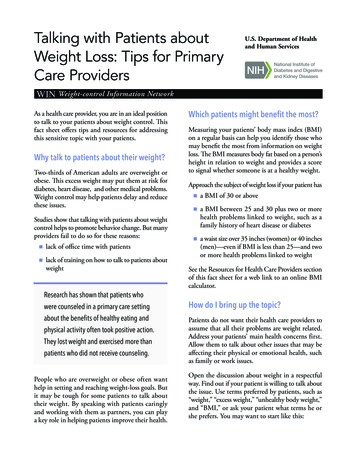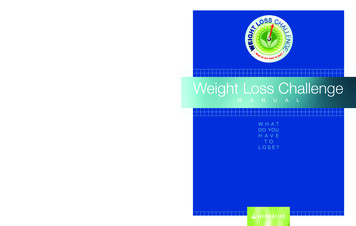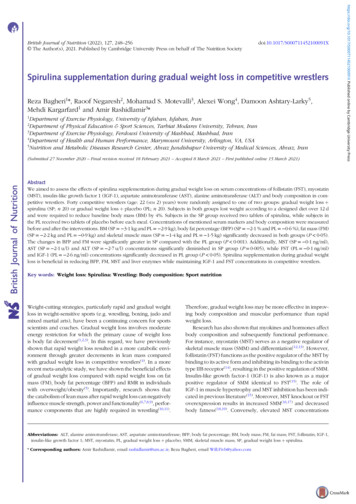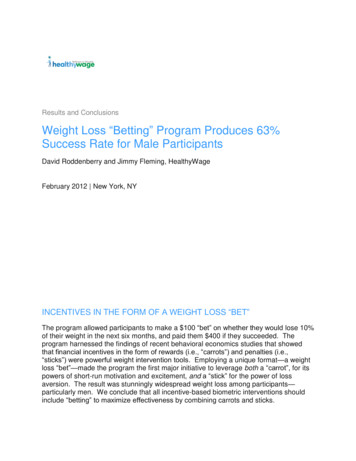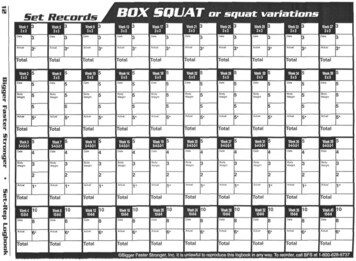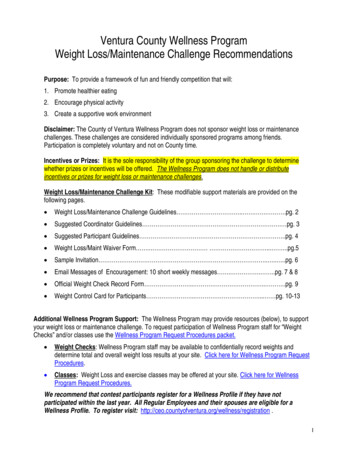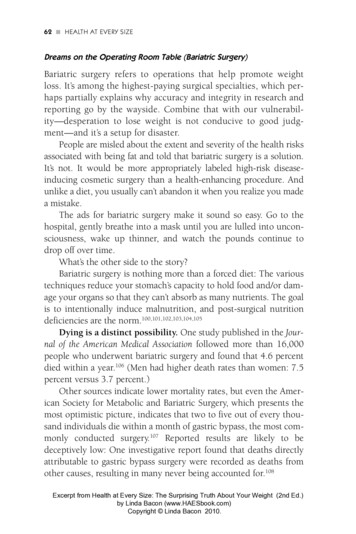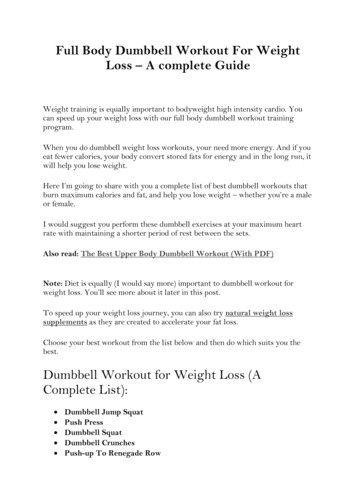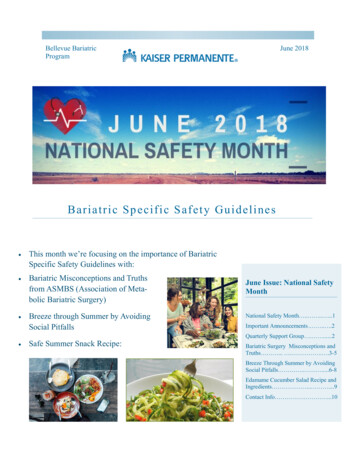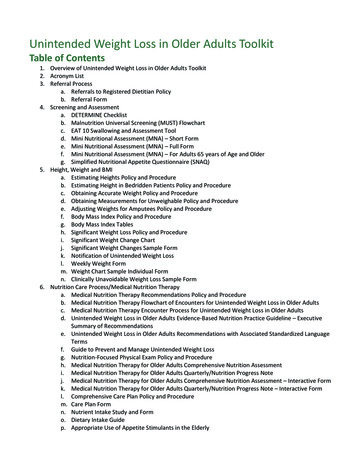
Transcription
Unintended Weight Loss in Older Adults ToolkitTable of Contents1. Overview of Unintended Weight Loss in Older Adults Toolkit2. Acronym List3. Referral Processa. Referrals to Registered Dietitian Policyb. Referral Form4. Screening and Assessmenta. DETERMINE Checklistb. Malnutrition Universal Screening (MUST) Flowchartc. EAT 10 Swallowing and Assessment Toold. Mini Nutritional Assessment (MNA) – Short Forme. Mini Nutritional Assessment (MNA) – Full Formf. Mini Nutritional Assessment (MNA) – For Adults 65 years of Age and Olderg. Simplified Nutritional Appetite Questionnaire (SNAQ)5. Height, Weight and BMIa. Estimating Heights Policy and Procedureb. Estimating Height in Bedridden Patients Policy and Procedurec. Obtaining Accurate Weight Policy and Procedured. Obtaining Measurements for Unweighable Policy and Proceduree. Adjusting Weights for Amputees Policy and Proceduref. Body Mass Index Policy and Procedureg. Body Mass Index Tablesh. Significant Weight Loss Policy and Procedurei. Significant Weight Change Chartj. Significant Weight Changes Sample Formk. Notification of Unintended Weight Lossl. Weekly Weight Formm. Weight Chart Sample Individual Formn. Clinically Unavoidable Weight Loss Sample Form6. Nutrition Care Process/Medical Nutrition Therapya. Medical Nutrition Therapy Recommendations Policy and Procedureb. Medical Nutrition Therapy Flowchart of Encounters for Unintended Weight Loss in Older Adultsc. Medical Nutrition Therapy Encounter Process for Unintended Weight Loss in Older Adultsd. Unintended Weight Loss in Older Adults Evidence-Based Nutrition Practice Guideline – ExecutiveSummary of Recommendationse. Unintended Weight Loss in Older Adults Recommendations with Associated Standardized LanguageTermsf. Guide to Prevent and Manage Unintended Weight Lossg. Nutrition-Focused Physical Exam Policy and Procedureh. Medical Nutrition Therapy for Older Adults Comprehensive Nutrition Assessmenti. Medical Nutrition Therapy for Older Adults Quarterly/Nutrition Progress Notej. Medical Nutrition Therapy for Older Adults Comprehensive Nutrition Assessment – Interactive Formk. Medical Nutrition Therapy for Older Adults Quarterly/Nutrition Progress Note – Interactive Forml. Comprehensive Care Plan Policy and Procedurem. Care Plan Formn. Nutrient Intake Study and Formo. Dietary Intake Guidep. Appropriate Use of Appetite Stimulants in the Elderly
q. Considerations for Medical Nutrition Therapy Interventionsr. Recommendation Forms. Nutrition Risk Meetingt. Dining Experience Policy and Procedureu. Case Study for Unintended Weight Loss in Older Adults7. Enteral Nutrition and End of Life Decisionsa. Guidelines for Enteral Feeding Eligibility Policy and Procedureb. Enteral Feeding and Nutrition Care Assessment Policy and Procedurec. Guidelines for Enteral Feeding Policy and Procedured. Documentation for Enteral Feeding Policy and Proceduree. Enteral Nutrition Progress Reportf. Enteral Nutrition Flowsheet Policy and Procedureg. Enteral Nutrition Flowsheeth. Transition to Oral Feedings Policy and Procedurei. End of Life Decisions Policy and Procedure8. Education Materials and Professional Resourcesa. Summary of Education Materials and Resourcesb. Enhancing Nutritional Valuec. Six Small Meals Dietd. Get Your Plate in Shapee. My Plate for Older Adults9. Outcomes Managementa. Outcomes Management: Nutrition Monitoring and Evaluationb. Outcomes Management Forms in Excel
Step 1 BMI scoreBMI kg/m 2 20 ( 30 Obese)18.5 - 20 18.5Score 0 1 2If unable to obtain height and weight, seereverse for alternative measurementsand use of subjective criteriaStep 2Step 3 Weight loss scoreAcute disease effect scoreUnplannedweight loss inpast 3-6 months%Score 5 05 -10 1 10 2If patient is acutely ill andthere has been or is likelyto be no nutritionalintake for 5 daysScore 2Step 4Acute disease effect is unlikely toapply outside hospital. See ‘MUST’Explanatory Booklet for furtherinformationOverall risk of malnutritionPLEAdd Scores together to calculate overall risk of malnutritionScore 0 Low Risk Score 1 Medium Risk Score 2 or more High RiskStep 5SAMManagement guidelines0Low Risk1Medium Risk2 or moreHigh RiskRoutine clinical careObserveTreat*Repeat screeningHospital – weeklyCare Homes – monthlyCommunity – annuallyfor special groupse.g. those 75 yrsDocument dietary intake for3 daysIf adequate – little concern andrepeat screeningHospital – weeklyCare Home – at least monthlyCommunity – at least every2-3 monthsIf inadequate – clinical concern– follow local policy, set goals,improve and increase overallnutritional intake, monitor andreview care plan regularlyRefer to dietitian, NutritionalSupport Team or implementlocal policySet goals, improve and increaseoverall nutritional intakeMonitor and review care planHospital – weeklyCare Home – monthlyCommunity – monthly* Unless detrimental or no benefit isexpected from nutritional supporte.g. imminent death.All risk categories:Treat underlying condition and provide help andadvice on food choices, eating and drinking whennecessary.Record malnutrition risk category.Record need for special diets and follow local policy.Obesity:Record presence of obesity. For those withunderlying conditions, these are generallycontrolled before the treatment of obesity.Re-assess subjects identified at risk as they move through care settingsSee The ‘MUST’ Explanatory Booklet for further details and The ‘MUST’ Report for supporting evidence.
Medical Nutrition Therapy Flowchart of Encounters forUnintended Weight Loss in Older AdultsThis document is designed to assist registered dietitians and registered dietitian nutritionists (RDN) in completing theMedical Nutrition Therapy for Older Adults Comprehensive Nutrition Assessment and Quarterly/Nutrition ProgressNote, also located in this toolkit. A more extensive description of each encounter is located in the Medical NutritionTherapy Encounter Process.The format follows the Nutrition Care Process, which includes Nutrition Assessment, Nutrition Diagnosis, NutritionIntervention, and Nutrition Monitoring and Evaluation, also known as the “ADIME” format. When completing theAssessment and Quarterly/Nutrition Note, use of the most current Academy of Nutrition and Dietetics StandardizedLanguage manual is also recommended. For more information on the Academy Nutrition Care Process and StandardizedLanguage, see t.aspx?id 7077 .Screening/Referral/Consult InformationE1. HBCS and Assisted Living: 30 days OR 2. SNF and NF: 5-14 daysRelated documents/forms:PLDetermine ChecklistEAT 10MNA Short FormMSNAQSample Policy: Referrals to Registered Dietitian/Dietetic Technician, Registered (RD/DTR) Communication/Referrals ForRD/DTR ProfessionalSARD to obtain pertinent clinical data from referral source or individual’s medical record or information system. Laboratory values (e.g., HgbA1c, CMP, CBC) Other clinical data: Anthropometric data (e.g., height,weight, weight change)Physician, nurse practitioner or physician assistantreferral with signaturePast medical history: Recent hospitalization, surgeries,fractures, admission to healthcare communitiesNutrition Screening Risk Score (from MNA- SF orDetermine Checklist) Swallowing problems, eating dependency, low physicalactivity level, decreased activities of daily livingPresenting signs and symptomsMedications (dose, frequency), dietary/herbalsupplementsPhysical activity clearance or limitations
Eat RightFood, Nutrition and Health Tips from the Academy of Nutrition and DieteticsPLBefore you eat, think about what goeson your plate or in your bowl. Foods likevegetables, fruits, whole grains, low-fat dairyproducts and lean protein foods containthe nutrients you need without too manycalories. Over the day, include foods fromall the food groups. Try the following tips to“Get Your Plate in Shape.”EGet Your Plate in ShapeSAMMake half your plate fruits and vegetables.Eat a variety of vegetables, especially darkgreen, red and orange vegetables plus beansand peas. Fresh, frozen and canned vegetablesall count. Choose “reduced sodium” or“no-salt-added” canned vegetables.Add fruit to meals and snacks. Buy fruits that are dried, frozen or canned in water or100% juice, as well as fresh fruits.Make at least half your grains whole.Choose 100% whole-grain breads, cereals, crackers, pasta and brown rice.Check the ingredients list on food packages to find whole-grain foods.Switch to fat-free or low-fat milk.Fat-free and low-fat milk have the same amount of calcium and other essential nutrientsas whole milk, but less fat and calories.If you are lactose intolerant, try lactose-free milk or a calcium-fortified soy beverage.Vary your protein choices.Eat a variety of foods from the protein food group each week, such as seafood, nuts andbeans, as well as lean meat, poultry and eggs.
Mini Nutritional Assessment (MNA) - For Adults 65 years of Age and Older g. Simplified Nutritional Appetite Questionnaire (SNAQ) 5. Height, Weight and BMI a. Estimating Heights Policy and Procedure b. Estimating Height in Bedridden Patients Policy and Procedure c. Obtaining Accurate Weight Policy and Procedure d.

